[ Retro Scan Special ] IBM Taught Me How to Read
July 11th, 2010 by Benj EdwardsPeriodically, I visit my parents’ house and pick through the material vestiges of my childhood. Old toys, broken knickknacks, and drawings rendered in crayon litter their dusty attic. My mom, being the mother she was, tucked them away as small monuments to her child’s journey through life. I’m happy she did.
During one of these visits in 2008, I ran across this curious artifact of my early education. It’s one of my kindergarten spelling workbooks, still filled out in my meandering 5-year old hand all these years later.
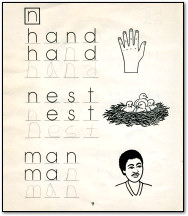
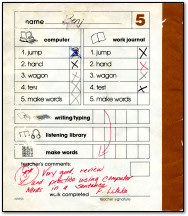
As I flipped through its pages, memories of my kindergarten year — 1986 — began to bubble up from the deepest corners of my brain. I remembered the workbook’s contents surprisingly well: it contained simple words with letters omitted, replaced with blanks in which I scrawled awkward glyphs.
I recalled having my spelling knowledge put to the test on primitive PCs of the day, which I had always assumed were Apple IIs in retrospect. But when my eyes fell upon the famous IBM logo printed on the cover, a strange realization washed over me: IBM taught me how to read.
Behind the Curtain
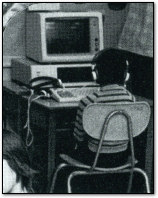 Once a week, my kindergarten teacher made our class form a single-file line. She’d lead us down the hall and into the school’s auditorium. There, we’d march up the steps and duck behind a velvety curtain to find a row of five or six IBM PCs positioned against the back wall of the stage. The fabric partition dampened any chance of an echo, and it made the tall, narrow space feel like a large coat closet. I still recall the smell of ancient dust and floor wax that seemed to permeate every crevice of that building.
Once a week, my kindergarten teacher made our class form a single-file line. She’d lead us down the hall and into the school’s auditorium. There, we’d march up the steps and duck behind a velvety curtain to find a row of five or six IBM PCs positioned against the back wall of the stage. The fabric partition dampened any chance of an echo, and it made the tall, narrow space feel like a large coat closet. I still recall the smell of ancient dust and floor wax that seemed to permeate every crevice of that building.
A single line of dim, low-wattage bulbs lit the backstage area with an orange glow. The darkness emphasized the iridescent green of the PCs’ monochrome monitors, which cast a soft light on anyone sitting before them.
Other kids usually went first, stepping up to the computers and slipping on headphones. When it was my turn, the teacher would guide me to an unoccupied PC and help me get started. I’d begin my weekly spelling test, which would be officiated by software specially designed by IBM. Synthesized speech would issue forth from my headphones — usually a word at a time — and my task was to type out those words properly. When I was done, I’d surrender the computer to another student and wait. We’d all return to the classroom together.
Here’s a shot from my elementary school yearbook showing the whole system in action, albeit not in the auditorium as I experienced it:
IBM’s Writing to Read Program
 It turns out I was part of a much larger social experiment taking place in the 1980s that sought to answer this question: can computers help children learn?
It turns out I was part of a much larger social experiment taking place in the 1980s that sought to answer this question: can computers help children learn?
The question was further narrowed, in this case, to the subject of reading by both IBM — who was eager to outfit schools with scores of its computers — and a zealous education specialist named John Henry Martin. Martin’s approach at promoting literacy emphasized learning to write and read at the same time, so he called his method “Writing to Read.” In his plan, computers would only be one part of the educational equation; he envisioned the PC as a technological delivery vehicle for his methods — an “individual tutor” that would carry out his curriculum exactly, without deviation, every time.
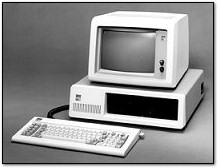 Their combined mission was to help kids learn to read — and, of course, to make money. IBM especially targeted impoverished areas with low rates of student literacy. It’s always convenient when community outreach includes the sales of $20,000 to $65,000 worth of your product per school.
Their combined mission was to help kids learn to read — and, of course, to make money. IBM especially targeted impoverished areas with low rates of student literacy. It’s always convenient when community outreach includes the sales of $20,000 to $65,000 worth of your product per school.
So did it work? According to some studies, the IBM Writing to Read program provided no advantage over traditional non-computer techniques, and it added significant (and unnecessary) cost to the process. Come to think of it, what role did the computer play in the program that a human teacher couldn’t easily replicate?
Sharman Ramsey was especially critical of the program when writing about it in 1995:
One wonders at administrators’ eagerness to spend great sums on an ineffective gimmick. But, grants and federal funding make this tempting technology accessible to impoverished school districts. Then, in spite of gleaming new computer labs, they are no better off academically than before. In fact, with the high cost of upkeep putting demands on scarce local funds, the new technology actually prevents districts from contracting with those companies with successful methods to produce literate children. As one principal put it, “We’ve got too much invested in this to change.”
Others, especially IBM and Martin, emphasized whatever minimal benefits they could extract from academic studies of the program, and some teachers swore by its efficacy.
From my personal experience as part of the program (for one year), I did learn to read at the right age — and I enjoyed the process — but I can’t say I learned to read any better than I would have without the computers around. After my kindergarten year, I switched schools, and I used old fashioned books from then on. They did the job just fine.
As far as I know, the Writing to Read program continued into the late 1990s. I’m not sure if schools still use computers to teach reading to kindergarten-level kids anymore, but I wouldn’t be surprised if there were still plenty of companies around to capitalize on educational fads that happen to involve expensive, emerging, and barely understood technology. There’s good money in it, you know.
—
Discussion Topic of the Week: Did you use educational software in school as a kid? Tell us about it.
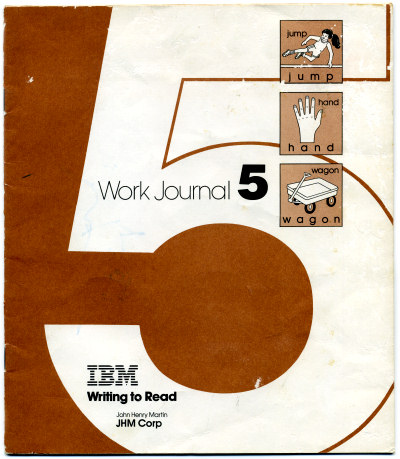
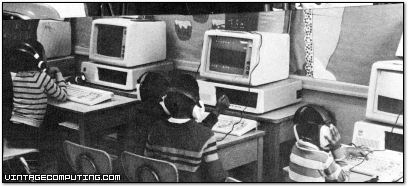


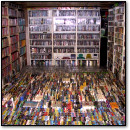
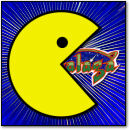
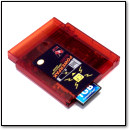
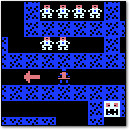
July 12th, 2010 at 2:34 pm
Did they make you touch the giant metal desk the computer was sitting on to ‘ground’ yourself before you turned it on?
July 12th, 2010 at 5:09 pm
My elementary school had an Apple II computer lab we would go to about twice a week. There were several educational titles they would make us play but I don’t remember any except “Number Munchers”. It had a grid layout with answers to math problems and you moved your character to the correct answer while trying to avoid enemies. It was somewhat like Pac-Man. Here’s a great site for it.
http://www.pcgaming.ws/viewgame.php?game=number_munchers
July 13th, 2010 at 5:05 am
Another kid of the eighties here. Our primary (elementary) school was dabbling with computers at the same time. Since this was Britain, we’re talking BBC Micros. And since this was the eighties, we’re talking one single machine, for a school of 100-150 pupils. They put it on a cart and you’d see it wheeled into your classroom once in a while. We liked it because it distracted our completely computer illiterate teachers who would take turns at laboriously following the handwritten instructions taped to the top of the boxy monitor.Â
I honestly can’t remember ever using it as intended. Presumably there were programs to load from cassette tape, but the teachers struggled so badly we scarcely saw anything. They lost patience after a while and, eventually, I happened to get some time on it to myself; illegitimately. Hey, I could work a power switch.Â
Imagine the confusion when other kids reported the computer was asking for help. No one had reckoned for a primary schooler who knew BASIC. We had our own Commodore Vic-20 at home and I knew a few simple commands. Turned out, of course, that the BBC accepted them as well. So I cobbled up a little print > input > goto loop, if I remember, where the BBC kept asking why it was trapped here, over and over. Soon had the class in hysterics when it caught the teacher.Â
Last time they let me near the thing. I think it was soon retired.Â
Later on, in our last year, we had a day-trip to the local high school where we were showed off such awesome things as a canteen and actual art rooms. (Our primary was among the smallest in Edinburgh, and stuck in sixties when it was built.) But the computer labs were, of course, the highlight. Imagine it: entire city worths of BBCs lined up, rows deep. Once again, no one on hand seemed to know how to use them, this was apparently part and parcel with computers. I did like the giant print out overhead though. “Murphy’s Law.”
They kept the best thing till last. One BBC was special. It had the laserdisc reader and upgrade required to play the Doomsday Project. This was a digital encyclopaedia the BBC had put together with schools across the country, rich with a curious mix of low res, garish graphics and full motion video. I remember the trackball they used to navigate it. I was more into the weird technology than the content on the giant disc.Â
http://en.wikipedia.org/wiki/BBC_Domesday_Project
Anyway, I went to another high school. They had Macs, but it was years before we got to use them. First self explanatory computers I ever saw.
July 13th, 2010 at 8:05 am
Like Kevin and millions of other kids growing up in the 80’s, we had the Apple II. As far as educational games, we had Number Munchers, Reader Rabbit, Where in the World Is Carmen Sandiego?, and Oregon Trail.
July 13th, 2010 at 10:42 am
My elementary school had some number (I want to say 4?) of Commodore PETs in the library. As part of the GATE program, we would spend time on them learning BASIC, writing little programs to animate a horse galloping – or for one enterprising kid, animating a dude breakdancing. Again, the ’80s.
I was curiously sheltered from Apple computers as I grew up, just by happenstance. My dad bought an Atari 800, and later a 286. In middle school the lab had Apples, but never took the computer elective to spend time in there. High school had IBM PS/2s.
Later on, my dad became a convert to Apple, but it wasn’t until the second coming of Jobs that I switched.
July 21st, 2010 at 9:08 pm
My dad worked for Atlanta Public School System for 30 years, I spend most of my childhood using Writing to Read. What a throwback. Thanks for this post!
February 3rd, 2011 at 11:41 pm
Another 80s child here, and we used to use BBC Micros in Australia. They taught us how to do LOGO programming, and then we’d play all kinds of games that taught maths and logic problems… one of them in particular I remember was about shrinking down and going through this city within an integrated circuit.
We would save our games as we progressed, and one day I got far enough that it crashed out. I knew a little BASIC and could list what had happened but was too young to understand how to fix it.
I’d like to find out that program’s name.
April 11th, 2014 at 3:11 am
Thank you for this post! I went to kindergarten in 86-87 and have been looking for what these books were called. I have such a strong memory of how these workbooks looked and using the computers.
December 28th, 2023 at 9:16 am
We used Writing to Read in elementary. I went to a rural school that was tiny, and for whatever reason, RICH in grant funding. This was early 90s and from what my mom said (she was a teacher) the program was good at our school because we had 1 computer for every 2 students, about 10 PS/2 Model 25s per classroom, which from everything I’ve read was not the common setup in big schools, where students had to go to a lab. We never had to take turns/wait because there were so many computers. There were tons of games on those and a lot of them were multiplayer and a lot of fun. Touch Typing. Writing to Read, Writing to Write, Math Cycles. I remember the token ring cables later in elementary (the school district kept those computers running for years) you would have to wiggle the hub connections to get them to boot up sometimes. Fun times